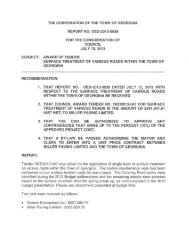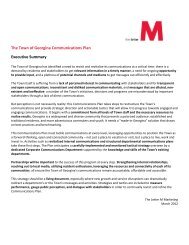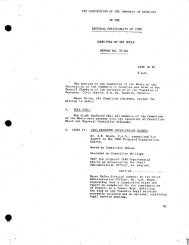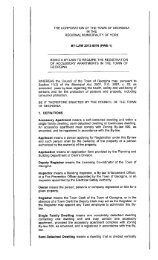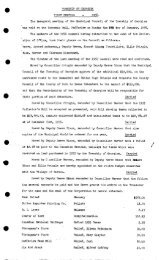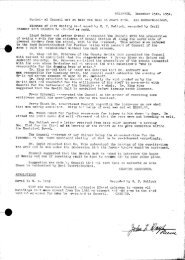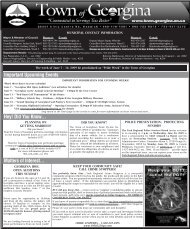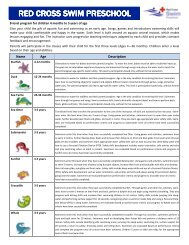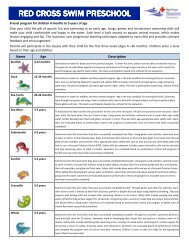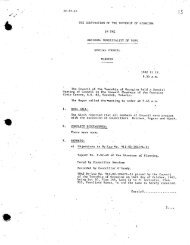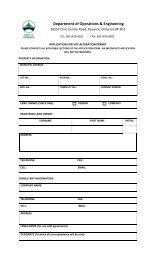Provincial Policy Statement - Ministry of Municipal Affairs and Housing
Provincial Policy Statement - Ministry of Municipal Affairs and Housing
Provincial Policy Statement - Ministry of Municipal Affairs and Housing
You also want an ePaper? Increase the reach of your titles
YUMPU automatically turns print PDFs into web optimized ePapers that Google loves.
PROVINCIAL POLICY STATEMENT<br />
secondary plans) are required before development<br />
applications can be considered for approval, only<br />
l<strong>and</strong>s that have commenced the more detailed<br />
planning process are considered to be designated for<br />
the purposes <strong>of</strong> this definition.<br />
Designated growth areas: means l<strong>and</strong>s within<br />
settlement areas designated in an <strong>of</strong>ficial plan for<br />
growth over the long-term planning horizon provided<br />
in policy 1.1.2, but which have not yet been fully<br />
developed. Designated growth areas include l<strong>and</strong>s<br />
which are designated <strong>and</strong> available for residential<br />
growth in accordance with policy 1.4.1(a), as well as<br />
l<strong>and</strong>s required for employment <strong>and</strong> other uses.<br />
Designated vulnerable area: means areas defined<br />
as vulnerable, in accordance with provincial<br />
st<strong>and</strong>ards, by virtue <strong>of</strong> their importance as a drinking<br />
water source that may be impacted by activities or<br />
events.<br />
Development: means the creation <strong>of</strong> a new lot, a<br />
change in l<strong>and</strong> use, or the construction <strong>of</strong> buildings<br />
<strong>and</strong> structures, requiring approval under the Planning<br />
Act, but does not include:<br />
a) activities that create or maintain infrastructure<br />
authorized under an environmental assessment<br />
process;<br />
b) works subject to the Drainage Act; or<br />
c) for the purposes <strong>of</strong> policy 2.1.3(b), underground<br />
or surface mining <strong>of</strong> minerals or advanced<br />
exploration on mining l<strong>and</strong>s in significant areas<br />
<strong>of</strong> mineral potential in Ecoregion 5E, where<br />
advanced exploration has the same meaning as<br />
under the Mining Act. Instead, those matters<br />
shall be subject to policy 2.1.4(a).<br />
Dynamic beach hazard: means areas <strong>of</strong> inherently<br />
unstable accumulations <strong>of</strong> shoreline sediments along<br />
the Great Lakes - St. Lawrence River System <strong>and</strong><br />
large inl<strong>and</strong> lakes, as identified by provincial<br />
st<strong>and</strong>ards, as amended from time to time. The<br />
dynamic beach hazard limit consists <strong>of</strong> the flooding<br />
hazard limit plus a dynamic beach allowance.<br />
Ecological function: means the natural processes,<br />
products or services that living <strong>and</strong> non-living<br />
environments provide or perform within or between<br />
species, ecosystems <strong>and</strong> l<strong>and</strong>scapes. These may<br />
include biological, physical <strong>and</strong> socio-economic<br />
interactions.<br />
Employment area: means those areas designated in<br />
an <strong>of</strong>ficial plan for clusters <strong>of</strong> business <strong>and</strong> economic<br />
activities including, but not limited to,<br />
manufacturing, warehousing, <strong>of</strong>fices, <strong>and</strong> associated<br />
retail <strong>and</strong> ancillary facilities.<br />
Endangered species: means a species that is listed<br />
or categorized as an “Endangered Species” on the<br />
Ontario <strong>Ministry</strong> <strong>of</strong> Natural Resources’ <strong>of</strong>ficial<br />
species at risk list, as updated <strong>and</strong> amended from<br />
time to time.<br />
Erosion hazard: means the loss <strong>of</strong> l<strong>and</strong>, due to<br />
human or natural processes, that poses a threat to life<br />
<strong>and</strong> property. The erosion hazard limit is determined<br />
using considerations that include the 100 year erosion<br />
rate (the average annual rate <strong>of</strong> recession extended<br />
over an one hundred year time span), an allowance<br />
for slope stability, <strong>and</strong> an erosion/erosion access<br />
allowance.<br />
Fish: means fish, which as defined in S.2 <strong>of</strong> the<br />
Fisheries Act, c. F-14, as amended, includes fish,<br />
shellfish, crustaceans, <strong>and</strong> marine animals, at all<br />
stages <strong>of</strong> their life cycles.<br />
Fish habitat: as defined in the Fisheries Act, c. F-<br />
14, means spawning grounds <strong>and</strong> nursery, rearing,<br />
food supply, <strong>and</strong> migration areas on which fish<br />
depend directly or indirectly in order to carry out<br />
their life processes.<br />
Flood fringe: for river, stream <strong>and</strong> small inl<strong>and</strong> lake<br />
systems, means the outer portion <strong>of</strong> the flood plain<br />
between the floodway <strong>and</strong> the flooding hazard limit.<br />
Depths <strong>and</strong> velocities <strong>of</strong> flooding are generally less<br />
severe in the flood fringe than those experienced in<br />
the floodway.<br />
Flood plain: for river stream, <strong>and</strong> small inl<strong>and</strong> lake<br />
systems, means the area, usually low l<strong>and</strong>s adjoining<br />
a watercourse, which has been or may be subject to<br />
flooding hazards.<br />
Flooding hazard: means the inundation, under the<br />
conditions specified below, <strong>of</strong> areas adjacent to a<br />
shoreline or a river or stream system <strong>and</strong> not<br />
ordinarily covered by water:<br />
a) Along the shorelines <strong>of</strong> the Great Lakes - St.<br />
Lawrence River System <strong>and</strong> large inl<strong>and</strong> lakes,<br />
the flooding hazard limit is based on the one<br />
hundred year flood level plus an allowance for<br />
wave uprush <strong>and</strong> other water-related hazards;<br />
b) Along river, stream <strong>and</strong> small inl<strong>and</strong> lake<br />
systems, the flooding hazard limit is the greater<br />
<strong>of</strong>:<br />
1. the flood resulting from the rainfall actually<br />
experienced during a major storm such as<br />
the Hurricane Hazel storm (1954) or the<br />
30



